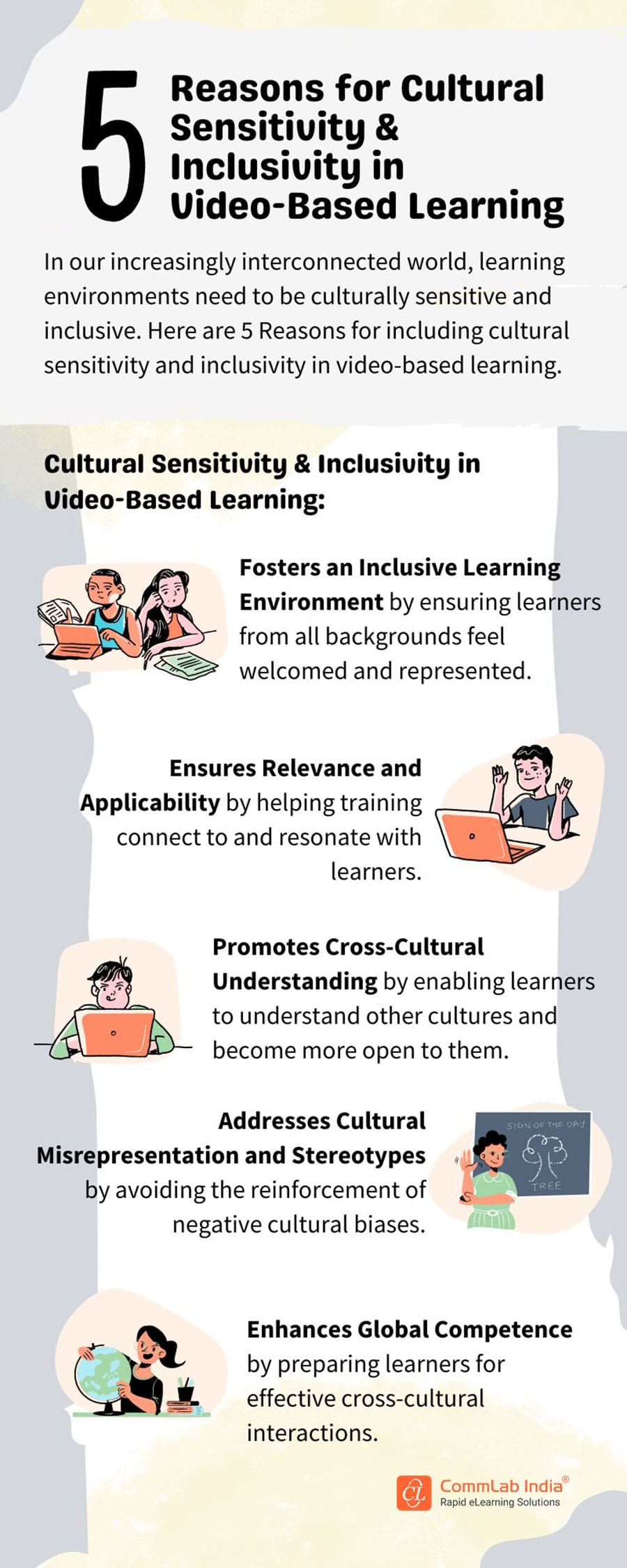How Video-based Learning can Build a Culture of DEI [Infographic]
![How Video-based Learning can Build a Culture of DEI [Infographic] How Video-based Learning can Build a Culture of DEI [Infographic]](https://blog.commlabindia.com/hubfs/blogs/video-based-learning-inclusive-infographic.jpg)
Incorporating videos into learning materials has become a popular and effective strategy for engaging learners and offering essential training. However, it's important to recognize that not all learners may have the same experience with video content. While videos have the potential to captivate and train, overlooking cultural sensitivity and failing to ensure inclusivity within video content can alienate certain learner groups. Without careful consideration of cultural diversity and sensitivity, videos may unintentionally reinforce stereotypes, perpetuate biases, or exclude individuals from diverse backgrounds.
Let's delve into the advantages of creating videos that prioritize inclusivity and cultural sensitivity, as well as discover some useful tips to achieve this goal.
Benefits of Designing Inclusive and Culturally Sensitive Videos
Tips to Design Diverse Video-based Learning
1. Focus on Cultural Context
Incorporating culturally relevant content not only enhances the relevance and relatability of the videos but also demonstrates a commitment to inclusivity and respect for diversity within your organization. This entails understanding the values, beliefs, and norms that shape the perspectives of your diverse audience members. By acknowledging and respecting cultural differences, you can tailor examples, and scenarios in your videos to resonate with various cultural backgrounds. Moreover, by incorporating examples and scenarios that reflect diverse cultural contexts, you can foster a sense of connection and belonging among all learners.
2. Consider Various Languages
Providing subtitles or transcripts in multiple languages ensures that learners, regardless of their primary language, can access and comprehend the content effectively. This accommodates individuals with varying language proficiencies and facilitates a more inclusive learning environment, acknowledging the linguistic diversity within your audience.
Beyond mere accommodation, offering subtitles in multiple languages promotes accessibility and helps learners engage more deeply with the material. It caters to those who may find it more comfortable to learn in their native language, enhancing comprehension and retention. providing multilingual subtitles or transcripts is a proactive step towards fostering an inclusive and equitable learning environment where all individuals can participate and benefit from video-based learning initiatives.
→ Download Now: The Why, How, and Where of Video-based Learning [Infographic]
3. Add Inclusive Imagery
Choosing imagery that is respectful and inclusive is essential in creating culturally sensitive and inclusive videos. It involves careful consideration of visuals to ensure they accurately represent the diversity of cultures within your audience without resorting to stereotypes or cultural appropriation. By selecting images that reflect a range of cultural backgrounds, you create a visual narrative that resonates with learners from different ethnicities, fostering a sense of recognition and representation. Additionally, it's crucial to be mindful of avoiding symbols or imagery that may be offensive or culturally insensitive to certain groups.
4. Enhance Accessibility Features
Incorporating accessibility features into video content is essential to ensure that all learners, including those with disabilities, can fully engage with the material. Closed captions, for example, enable individuals with hearing impairments to access the spoken content of the video. Additionally, providing audio descriptions of visual elements ensures that individuals with visual impairments can understand the context of what is happening on the screen. By offering alternative formats, such as transcripts, video content becomes accessible to a broader range of learners, accommodating various needs and preferences. By prioritizing accessibility, organizations create an environment where all learners can participate actively and independently, regardless of their abilities.
To Wrap up!
Cultural sensitivity and inclusion are critical aspects of effective learning design, especially in today's multicultural and interconnected world. So, when developing videos, it's essential to take into account the diverse perspectives, experiences, and values of your learners.
By proactively addressing cultural considerations and incorporating inclusive practices into designing video content, organizations can create learning experiences that resonate with all learners, foster a sense of belonging, and promote greater understanding and empathy across diverse learner groups. To gain more insights on video-based learning, make sure to download our infographic which is a rich representation of A-Z of video-based learning.




![Video-based Learning — The Go-to Strategy for Modern Learners [Infographic]](https://no-cache.hubspot.com/cta/default/59327/01a6bcb1-79c8-44e5-ade9-be0c530d9ae3.png)


![Practical Issues of Framing Learning Objectives for Online Learning [Infographic]](https://blog.commlabindia.com/hubfs/Imported_Blog_Media/learning-objectives-1-2.jpg)